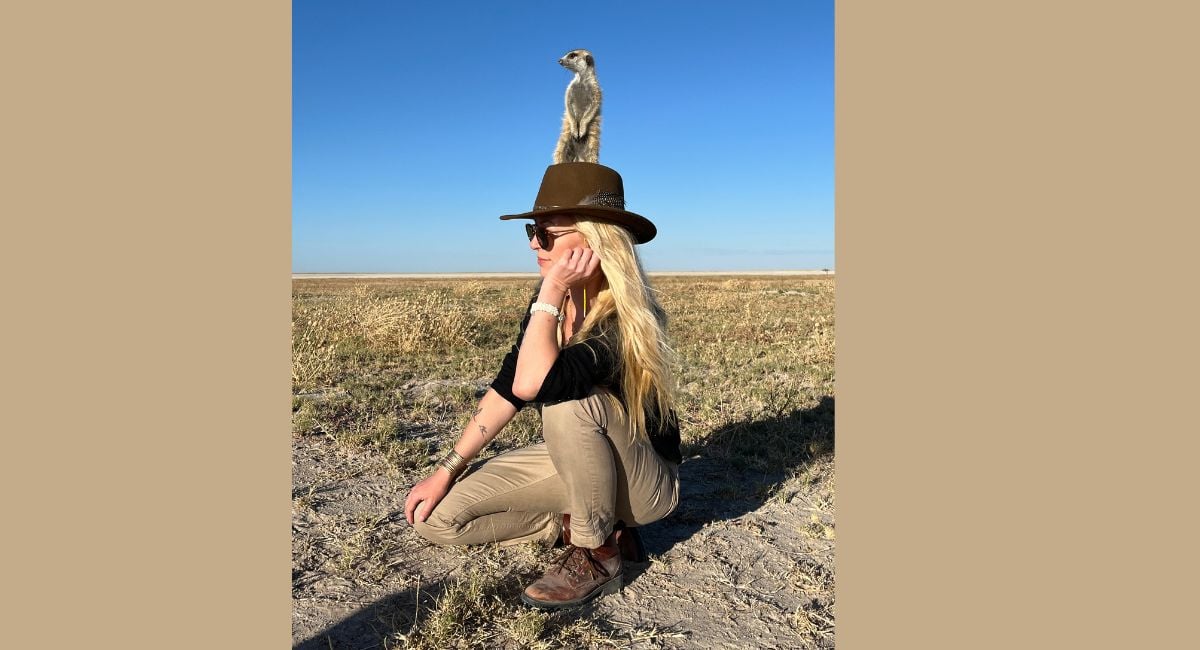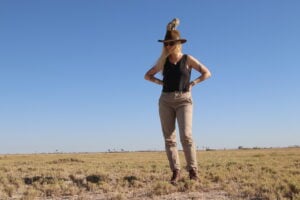Author’s Note: Many years ago, when planning a trip to Africa, I stumbled upon the Timbuku website, which was extraordinary in that it provided transparent pricing (RARE for a safari!), gave lodging options from which to choose (also RARE!), the ability to build my own trip (also rare!), and the ability to work with a consultant to fine-tune it. I met Joanna Rigby-Jones, who helped make the trip a reality. Since then, we’ve worked together on multiple trips to Africa (including one for 18 women) and on an upcoming trip to Egypt and Jordan. She was kind enough to share her story with me.
Few people can say they’ve walked across Tanzania with Maasai guides, lived in Paris and London, and built a career helping travelers discover Africa’s most magical corners. Joanna Rigby-Jones, senior travel specialist at Timbuktu Travel, has done all that—and more. I sat down with her to talk about her path from Maine to the African savannah, her favorite hidden gem destinations, and the hat she brings on every vacation.
Q: Joanna, let’s start at the beginning. How did you find your way into the world of travel?
A: I grew up on an island in Maine, and live there again now, but have always had itchy feet. My dad’s British, so I have dual citizenship, and I spent part of my childhood in England. After high school, I was ready to see the world—I lived in London, Paris, and Los Angeles for a while. I studied art and later earned a degree in environmental anthropology. I loved traveling, but didn’t realize it could be a career.
My first big trip to Africa was in my twenties—I backpacked across northern Tanzania with eight others and two Maasai guides. We walked across the country with no running water or electricity. I thought it would be my once-in-a-lifetime trip—and it completely changed my life.
Q: What were you doing before you joined Timbuktu?
A: I was working in business development for social housing in the UK—pitching local authorities on contracts for mental health and youth housing services. I liked it, but it wasn’t my passion.
Then, a UK company, Audley Travel, opened a Boston office. They took a chance on me even though I had no travel sales experience—just a lot of travel and enthusiasm! That’s when I started focusing on Africa, and I’ve now been to the continent 15-20 times.
Q: And now you’re with Timbuktu Travel—what drew you there?
A: I’d been working for a large, very traditional bespoke travel company—wonderful but very rigid. After having twins, I needed flexibility and a culture that valued balance. The daughter of the owner of a camp in Kenya that I love worked for Timbuktu. There were maybe five people at Timbuktu then. I reached out and became their first U.S. person. Their approach—transparent pricing, traveler collaboration, and sustainability—felt fresh and right. I became their first U.S. team member almost ten years ago. I personally cover Africa and Colombia (random, but I’ve been three times and love it). I also do Egypt and Jordan. Sub-Saharan Africa is still where I travel most.
Q: Timbuktu’s planning tool is unique—it lets travelers see prices and options online. How does that change the experience?
A: It’s incredibly empowering. You can play around with routes, camps, and budgets, then connect with us to refine them. We believe in collaboration—never just “here’s your package.” We guide travelers toward experiences that fit them, while ensuring responsible tourism: fair staff treatment, community support, and wildlife protection.
We also get insider rates through our Cape Town head office, so travelers aren’t paying extra for the expertise—they’re getting peace of mind and on-the-ground support.
Q: What trends are you seeing in African travel right now?
A: Responsible travel is huge—guests care about whether lodges are locally owned, if guides are from the community, and how the camps give back. There’s also been a rise in female guides, which is amazing to see. When I started, a female guide was rare!
I’m seeing more solo women travelers than ever before—safaris are naturally social, with shared tables and group drives, so it feels safe and connected.
Crowding has become a concern in certain parks, especially during migration season in Kenya and Tanzania, as seen in recent viral videos showing people out of cars, blocking animals, and more. It’s a huge problem. Many travelers are choosing private conservancies for a quieter, more ethical experience.
Q: What are your favorite “off-the-beaten-path” destinations in Africa for a unique, uncrowded experience?
- Botswana’s Okavango Delta – specific concessions are utterly pristine, if you know the right area to visit. I spent days there this past spring without seeing another vehicle.
- Southern Tanzania – the Nyerere (formerly Selous) and Ruaha parks. Fewer people, top-quality water and land-based activities—like Tanzania meets Botswana. Often a second/third safari pick, but some first-timers love it too.
- Zimbabwe’s Mana Pools – Super off the beaten path, phenomenal wild dogs and elephants. It’s a beautiful park. It tends to be pricey, but it’s amazing.
- Gorongosa, Mozambique – a conservation comeback story led by African Parks, now a model for wildlife restoration.
- Tswalu (South Africa) in the Kalahari—desert-adapted wildlife and pangolin conservation.
- I love Uganda—gorillas and chimps, great safari, Murchison Falls, rhino conservation. Uganda’s pretty special—even as a single-country trip.
Q: What destinations are high on your personal bucket list?
A: Definitely Gorongosa—I’m obsessed with what’s happening there. Also, when my twins, who are 10, are a bit older, I’d love to do a long self-drive in Namibia.
Outside of Africa, I’m dreaming of Antarctica and Mongolia. Mongolia’s Eagle Festival and wide-open steppes are truly off the beaten path and are calling my name.
Q: What do you think makes a great client?
A: Communication. If something doesn’t feel right—say so early! During the trip, speak up. One Nile cruise manager told me, “We’re good, but we can’t read minds.” Whether it’s a hard pillow or wanting more variety at dinner—tell us. We’ll fix it.
Q: How many trips are you planning at once?
A: It varies. January/February are the busiest booking months. In January I might book 10–15 trips and be actively working with 25–30 parties. Other months, I book 7–8, working with twice that. During the high travel season (July–October), I can have 15–20 groups traveling per month.
Q: What’s one of the strangest client requests you’ve ever had?
A: Oh, I’ve had a few! One guest wanted wild blueberries with breakfast every day. Another group arrived with 14 huge suitcases for a light-aircraft transfer—we had to charter another plane! Someone once sent a meal-by-meal list with exact food weights. But most travelers are wonderful.
Q: How do most of your clients find you?
A: About 40% are repeat clients. We hit number one with Travel + Leisure the first year we applied; this year we were second – so that helped, of course, as well. Our whole team made the Condé Nast Top Specialists list. So all that helps. People also love our website and find us via that as well. You can build a trip, seeing all the prices and options, and then be allocated to one of us to help build the trip.
Q: Egypt has been having a moment—what’s driving the buzz?
A: The opening of the Grand Egyptian Museum and the 2027 eclipse in Luxor have created huge demand—Luxor is already sold out for that period! People also feel it’s safe again, and it really is. Egypt and Jordan are two of my most popular destinations right now.
Q: Any essential safari packing tips?
-
- A packable, crushable, wide-brimmed Stetson hat is #1!. It pops back into shape after being in a suitcase. It’s my must-have, and I don’t travel without it!
- High-ankle leather boots (similar here and here)—comfy and they keep dust out. Mine are from L.L.Bean and are well broken in!
- Pants: loose linen; also, thicker khaki-colored pants. Lots from Banana Republic—affordable and easy. I wear long pants rather than shorts on safari.
- Tops: sleeveless base layer + lightweight linen button-down for layering.
- Warm layer: packable puffy (mine’s L.L.Bean)—mornings/evenings can be cold.
- Socks: Darn Tough wool— they have a lifetime guarantee.
- And always bring a scarf or bandana—useful for dust, sweat, or protecting your camera.
Q: Finally—what keeps you inspired after all these years?
A: The people. Our travelers are curious, kind, and adventurous. Our Timbuktu team is small but close-knit, and we share a real sense of purpose. I always tell my boss: I’ll retire from this company. There’s nowhere else I’d rather be.”
✨ Fab Five: Joanna’s Personal Favorite Trips at a Glance
- Makgadikgadi Pans, Botswana – the desert, the meerkats, time with the San community—the whole experience. I didn’t want to leave.
- Okavango Delta, Botswana – iconic water safaris and pure wilderness. Spectacular.
- Bwindi, Uganda – trekking with mountain gorillas. Absolutely incredible.
- Laikipia Plateau, Kenya – It has a conservation focus, and independently managed conservancies mean you can do off-roading, night drives, and bush walks. I grew up around horses (my mother was a racehorse trainer), so I love riding there.
- Nyerere (Selous), Tanzania – There are very few people, and it offers every activity—boat rides on the Rufiji River, fishing for tigerfish, bush walks, game drives. It’s great for wild dogs, and is easy to pair with a visit to Zanzibar.
- Bonus: And honestly, that early trek across northern Tanzania with Maasai guides was life-changing—very different from a typical tourist experience.
Joanna Rigby-Jones is a Senior Travel Specialist with Timbuktu Travel, helping travelers design personalized, responsible adventures across Africa and beyond. Feel free to reach out to her at joanna.rigbyjones@timbuktutravel.com.



